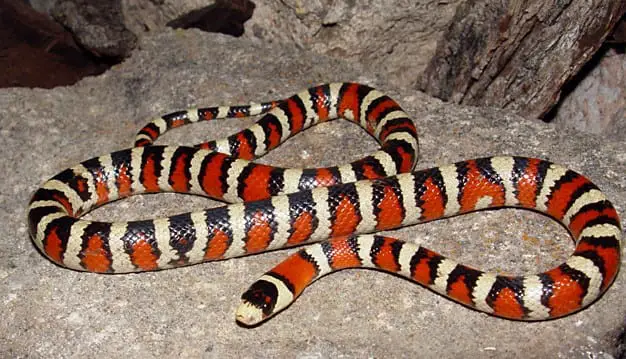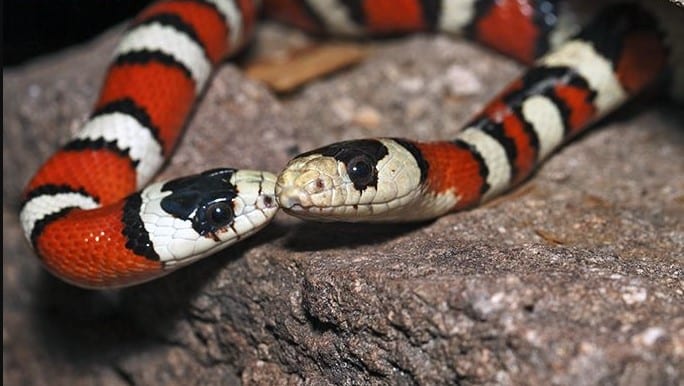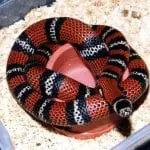Scientific Facts
| Common Name | Arizona Mountain Kingsnake |
| Scientific Name | Lampropeltis pyromelana |
| Life Span | 12 to 20 years |
| Size | 8 to 13 in. (hatchlings) and 18 to 43 in. (adults) |
| Habitat | Wooded areas, rock piles, along rivers, streams, and water aquatic areas |
| Country of Origin | United States (Arizona), Mexico, Sonora, Chihuahua |

Physical Description
The Arizona mountain kingsnake originates from the mountain of central and northern Arizona. They are considered as field herpes and is one of the most popular snakes in the world. It has whitish to yellowish snout, and their head is typically black on top. The kingsnake has flashes of red over their large eyes that sit beside their heads. Their bodies are encircled with more than 40 rings of black, yellow-white, and red bands. It’s a beautiful snake that is native to Arizona and can also be found in Utah, Nevada, and Mexico. These kingsnakes are rock-dwellers and prefer habitats that are near water sources. It’s also common to see them on top of tree trunks and hibernating in wooded areas.
Taking care of these snakes is very easy, and the care level is great for beginners. Young snakes can grow from 8 to 13 inches while the adults can reach more than 43 inches. The weight of an adult can range from 1 to 4 lbs. depending on their health. They also have longer brumation periods and experience shorter summers, just like any other kingsnakes. Although they are great for beginners, it’s important to treat these snakes as delicate.
The kingsnake is easy to handle, and there’s no need for you to place them in an extra-large cage or enclosure since they don’t particularly grow bug. Their size is very manageable as they can only grow from 3 to 4 feet. The average size is about 3 feet only. Buying these snakes is also not a problem since you can easily buy them in your local pet stores or from online pet shops.
Lifespan
These snakes can live for about 12 to 15 years in the wild but can survive for more than 20 years in captivity. Captive breeding can add years to their lives so long as the keeper can provide them all their needs. It’s important to conduct online research first before you decide to raise them. Temperature control is also crucial if you want to keep them healthy. When in captivity, you need to make sure that you keep the temperature between 80 to 85 degrees Fahrenheit and don’t forget to drop at least 5 to 10 degrees during night time.
Eating Habits
The snake can eat almost anything, and their growth rate is dependent on the size of their meals. It’s not recommended, though, that you overfeed or power feed these snakes since they are prone to regurgitation. Excessive regurgitation is unhealthy and can cause stress to your snakes. Also, don’t be alarmed if these snakes won’t eat what you’re feeding them since they are one of the pickiest pets on the planet. Compared to other kingsnakes, their growth rate may not be that fast.
Nonetheless, the goal of the keeper should always be to provide proper care and nutrition. Bear in mind the refusals of meals is pretty normal for these kingsnakes. It’s recommended that you try feeding them again next week. Remember that skipping over winter dormancy can affect their feeding habits. They will stop feeding if you don’t assist them to enjoy winter dormancy. Moreover, winter dormancy is also necessary if you’re planning to breed them.
Some novices think that these kingsnakes are difficult picky feeders, but the truth is, keepers just offer the wrong meals or food items. When feeding hatchlings, you can get introduce pinkie mice or lizards. It’s natural for them to smell the food first before eating it. You have to be patient, though, when trying to convince them to accept the food that you’re giving them.
Also, it’s important to note that Arizona mountain kingsnakes are considered as constrictors. This means that they constrict their prey before eating them. Constrictors do this to disrupt the circulation of blood in their prey’s brain. This kills the prey within seconds. They will then swallow the prey as a whole. You can feed your dear pets with mice, birds, bird eggs, amphibians, reptile eggs, rats, and even other venomous snakes. What’s interesting about these kingsnakes is that other venomous snakes are included in their diet.
Sleeping Habits
Arizona mountain kingsnakes are diurnal. These snakes are active during the day, most especially in the early summer. But scientists found out that they turn into nocturnal creatures once extreme hot summer arrives. Hibernating seasons start during winter and can last until late fall. This particular kingsnake loves to hunt for prey during day time, although there are instances when they go out in the night. Their daily activity heavily depends on the season or climate conditions. Once captured or feel threatened, these snakes roll into a ball. You’ll also see these snakes placing their heads inside the coil if they think that they are in danger.
Development and Reproduction
Before the Arizona Mountain Kingsnake breeds, they first emerge from brumation. This is how they can thrive and survive in rough weather conditions. Brumation is different from hibernation in a way where the snake undergoes less severe changes in their heart and respiration rate. There are also some changes in their body temperature, but again, it’s less stressful. When the weather conditions are too cold for them, the snake bromate. This is when their metabolism slows down, making the action. However, during sunny weather or warm climate conditions, the snake becomes active again. Arizona Mountain Kingsnake is more ‘wake” in the summer. And it’s important to note that although the snake is inactive during brumation, they still need water.
After emerging from brumation, the kingsnake gradually starts to gain its weight. This is also the time for them to look for their partners. They have incredible senses that help them quickly find their mating partners. At this point, the male snakes are so eager to ovulate the females. Meanwhile, the female ones are also ready prepared to lay their eggs. These snakes are considered as oviparous. They lay eggs instead of bearing live young snakes.
Female snakes can lay 3 to 20 eggs per clutch. Their eggs have leather texture and have a shape that of an oval. If you’re a breeder, then you can expect these eggs to hatch within 45 to 85 days. Once the eggs hatch, you should check the health of hatchling. They should be 7 to13 inches long. These young snakes reach their maturity age after 3 to 4 years.

How to Breed
Understanding the behavior and natural habitat of the Arizona mountain kingsnake is very important if you want to successfully breed them. Keepers need to be equipped with the right knowledge and skills to provide great care to the male and female snakes. It’s important to understand when is the best time for you to breed them. In the case of these kingsnakes, it’s recommended that you breed them after the brumation period where there is a rise in temperature. Of course, if you’re keeping them indoors, you should be able to control the environment without any problem.
Before breeding them, you must provide the female snake’s adequate vitamin D3. Be sure that you prep them before they become gravid. And even after the snake becomes gravid, you still need to make sure that you supplement their diet with vitamin D3. This is because, in their natural environment, vitamin D3 is essential for them to stay strong, healthy, and able to reproduce. You should also add some more calcium in their diet. Prioritize calcium rather than mice or insects.
Unlike other snakes, Arizona mountain kingsnakes tend to lay smaller clutches once a year. If you want your snake to remain healthy and reduce their stress levels, then it’s highly recommended that you only breed them every second year. Breeding them annually can be unhealthy for them. You want to preserve their health, and you want to ensure that they don’t get stressed out. This is the key to healthy kingsnake rearing.
To start breeding them, you must keep them asleep for 3 to 4 months. Then as the temperature rises, you should expect them to complete the brumation process. After warming up, you should give them food until they shed. You will then place the male in the enclosure where you’ve placed the female. Do this after their first molt. The females will sense that it’s a breeding season and so she releases pheromones and induces reproduction with him. You should observe them, especially in the first few hours. Remember that these snakes are cannibalistic, and you don’t want to see them eating each other out instead of breeding.
If the mating process is successful, then place her an enclosure that is filled with moistened vermiculite. Don’t forget to place a hole that is big enough for the female snake to crawl in and out. Don’t forget to check whether or not she has laid her eggs. Check several times a day and remember to give her enough water. Also, make sure that the female doesn’t lay her eggs in the water since this can lead to accidents, and the hatchlings might drown. And once the hatchlings emerge, you will then have to feed them after their first molt. You can offer frozen pinkies to them. But if they don’t eat it, then you can offer live ones. It’s also a good idea to start offering them with scented pinkies.
Common Health Problems
Internal and External Parasites
Arizona mountain kingsnakes are prone to parasites, and it can be external and internal. By external, we mean that your snake has been infected with worms or fungal infections. Meanwhile, external parasites mean that they have ticks and mites on their bodies. These parasites should be treated as soon as possible. You can give your snakes anti-parasitic treatment to kill worms or fungal infections. For external parasites, you should apply petroleum jelly to the affected area. It’s also a good idea that you send them to the veterinarian.
Dehydration and Regurgitation
Another common health problem that Arizona mountain kingsnakes encounter is dehydration and regurgitation. This happens when the keeper is not able to provide their snakes with the right diet and a healthy amount of water. Regurgitation can be very unhealthy for your snakes since it can bring heavy stress to their bodies. One of the causes of regurgitation is poor husbandry. Also, don’t forget that dehydration can be very deadly to your pet snakes. You should supply them with enough water supply. Controlling the humidity and providing optimal levels is also critical to avoid dehydration.
Shedding Problems
Shedding is normal for snakes; however, dysecdysis is not. Dysecdysis is a health problem where your snake is having a difficulty to complete a healthy shedding process. What you can do is you need to give more moisture inside the cage or enclosure. It’s also advisable that you mist them and at the same time, increase the temperature inside the enclosure. And more importantly, make sure as well that you clean their cage from time to time.
Preventing Illnesses
The best way for you to prevent illnesses and health problems is to ensure that you clean their cage regularly. Providing them the right meals and enough water supply is also crucial for them to stay healthy. Also, you must go to the veterinarian at least once a year to ensure that your snake is healthy and doesn’t have any diseases. Following the advice of fellow kingsnake enthusiasts on how to keep your snake healthy is also a great idea.
Behavior
You can find a lot of snake lovers today who collect Arizona mountain kingsnake. It’s considered as the “holy grail” of all kingsnakes. It’s very easy to take care of these snakes since they are not aggressive, although they can be quite delicate. Nonetheless, beginners can take care of them. Just make sure that you’re patient and that you don’t give up on them even if they sometimes become finicky or light eaters. You also won’t have to worry about their bites since they are not venomous.
Habitat
Housing
It’s recommended that you keep the adults in cages or enclosures that have at least 3L x 18W size. Although you can find keepers, who prefer smaller enclosures. You can also place them in a rack system since kingsnakes can thrive and survive in this kind of enclosure set-up. When housing hatchlings, make sure that the containers are escape-proof. You can use a reptile carpet substrate for these kingsnakes. Just make sure that they are clean and free from any bacteria or fungus.
Temperature, Humidity, Light
Providing an ambient temperature to these snakes, which is about 78F, is healthy for them. Don’t forget to drop the temperature by about 10 degrees during night time. Maintain the humidity between 40% to 60%. Providing them a proper light cycle is also important for them to remain healthy. Choose those bulbs or lighting systems that have 75 to 150 wattage.
Diet and Feeding
As mentioned earlier, these snakes can be quite finicky and delicate. For expert keepers, Arizona mountain kingsnakes that skip a meal or two is quite natural. These snakes fast on occasion, and so there’s nothing to worry about. You can feed them with lizards, pinkie, or mice. You can also witch to rodents from time to time. You can also add supplements on their diet since as vitamin D3 or calcium .
How to Care for Arizona Mountain Kingsnake
Replicating the environment of Arizona mountain kingsnake is essential. The key to proper care is to give them an environment where they can live happily. The enclosure should be clean and free from any harmful items and bacteria. You want the enclosure to be a safe place for them to eat, rest, drink, and breed. Regular cleaning of their enclosures is very important if you want to extend their lifespan. And if you truly care for your snakes, then make sure that you go to the veterinarian regularly – at least once a year for their annual general checkup.
Where to Get?
You can buy Arizona mountain kingsnake at your local pet store, or you can order them online. Some of the reliable and trusted sites where you can buy kingsnakes are Underground Reptiles, Backwater Reptiles, Morphmarket, and Snake at Sunset.
FAQs
Are Arizona mountain kingsnake venomous?
These snakes may bite, but they are not venomous. This is why these kingsnakes are recommended for beginners.
How big do they get?
These snakes can reach up to 42 inches.
What do Arizona mountain kingsnakes eat?
They love to eat pinkies, eggs, lizards, birds, and rodents.
How much do they usually cost?
Arizona mountain kingsnake is sold from $250 to $400 (average pricing). Also, it’s worth mentioning that those that have reduced black patterns on their back are more expensive.
Are they nocturnal?
Arizona mountain kingsnake is diurnal, which means that they are more active during the daytime.
How long do they live?
They can live for more than 20 years in captivity, provided that you care for them properly.
When is the best time for you to breed them?
After their brumation period, when there’s a slight increase in the temperature.
Are they good pets?
Yes, definitely. Aside from being one of the most beautiful kingsnakes out there, Arizona mountain kingsnakes are not venomous – although they can be aggressive sometimes.


